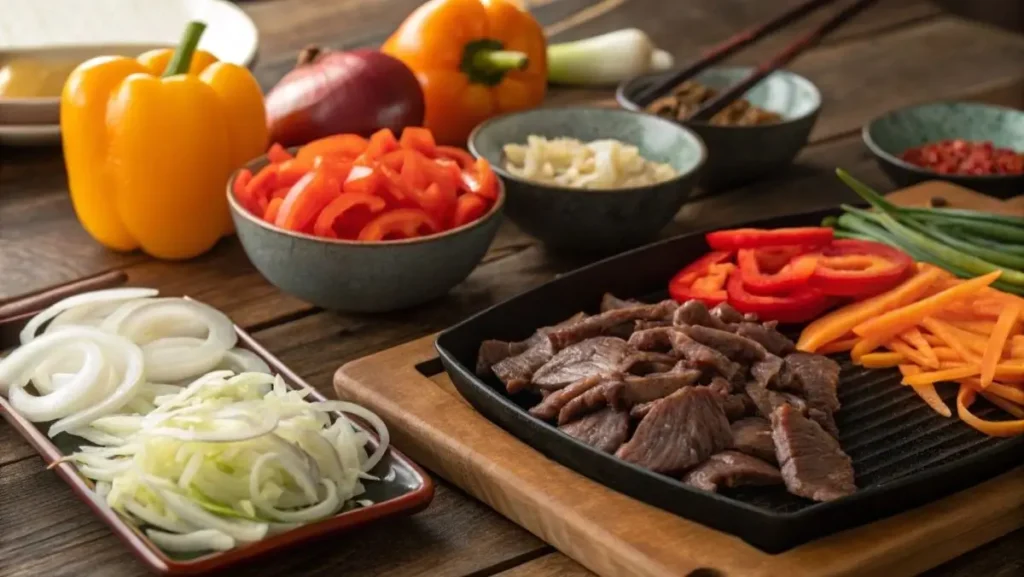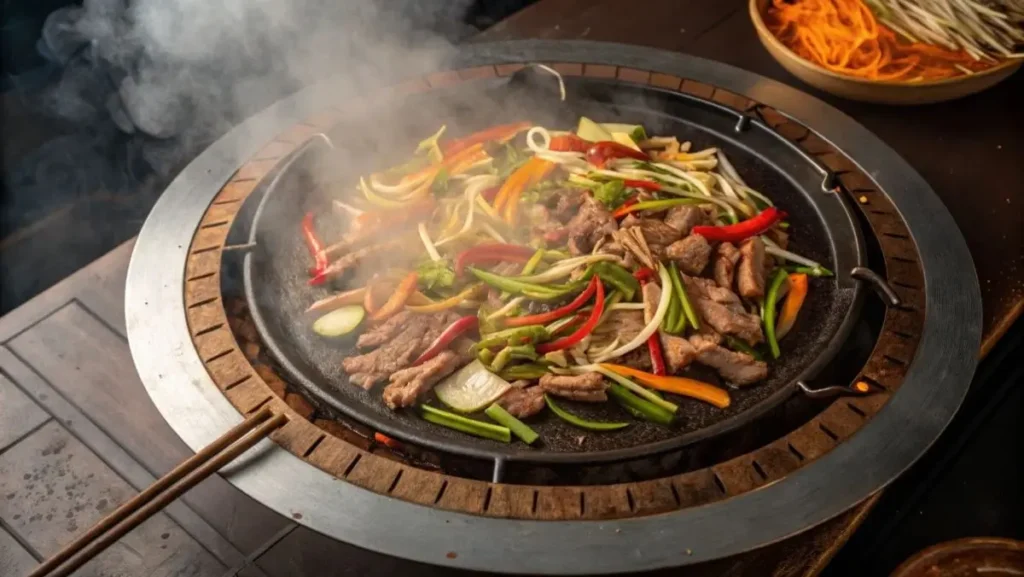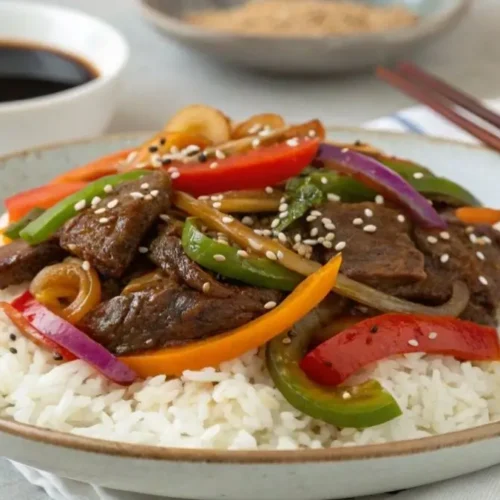Dive into the vibrant world of Mongolian BBQ, where tradition meets culinary creativity! This comprehensive guide unravels the origins, essential ingredients, and distinctive cooking methods that set Mongolian BBQ apart from other cuisines. Perfect for food lovers eager to expand their palates, this article not only educates on the cultural significance of this unique dining experience but also includes a delicious recipe to bring the flavors of Mongolia to your kitchen.
The Origins of Mongolian BBQ
Historical Background
Mongolian BBQ, often misunderstood as a traditional Mongolian dish, actually has roots that intertwine with the nomadic culture of Mongolia. Historically, Mongolian herders would cook their meals over open flames, using whatever ingredients they had on hand, which included thinly sliced meats and fresh vegetables. The influence of the Silk Road, a vital trade route, introduced various spices and cooking techniques that enriched Mongolian cuisine. Over time, these traditional cooking methods have transitioned into modern interpretations, leading to the vibrant dining experience we now know as Mongolian BBQ.

Cultural Significance
In Mongolian culture, communal dining plays a crucial role. Meals are often shared among family and friends, reflecting the values of hospitality and sharing that are central to their way of life. Mongolian BBQ embodies this spirit, as diners select their ingredients and watch them cook in front of them, creating a lively and interactive dining experience. With globalization, Mongolian BBQ has gained popularity worldwide, allowing people from different cultures to appreciate and enjoy this unique culinary tradition.For more communal meal inspiration, check out this guide to home decor and recipes for family gatherings.
Essential Ingredients in Mongolian BBQ
Key Components
The heart of Mongolian BBQ lies in its essential ingredients. Traditional meats such as beef, lamb, and chicken are commonly used, with beef being a standout choice for many. For a classic Mongolian beef recipe, thinly sliced beef pork chicken combinations can be utilized. Fresh vegetables like bell peppers, onions, and carrots not only enhance the flavor but also contribute to the dish’s nutritional value. Additionally, sauces and spices, such as soy sauce, brown sugar soy sauce, and red pepper flakes, play a significant role in elevating the overall taste.For more ideas on crafting delicious, flavorful dishes with fresh ingredients, visit Martha Stewart’s recipe collection.

Unique Flavor Profiles
The unique flavor profiles of Mongolian BBQ stem from the balance of savory, spicy, and umami tastes. Each ingredient contributes to this harmony, creating a dish that is both satisfying and delicious. When selecting ingredients, it’s essential to choose high-quality meats and fresh vegetables to ensure an authentic experience. The right combination of flavors can transform a simple meal into a culinary delight.
Unique Cooking Methods of Mongolian BBQ
The Traditional Cooking Process
The traditional Mongolian grill is a central feature of this cooking style. Typically round and made of metal, the grill is heated from below, allowing for even cooking. The cooking process involves placing thinly sliced meats and vegetables on the grill, where they are cooked quickly at high temperatures. The round shape of the grill is significant, symbolizing unity and community, as diners gather around to enjoy the meal together.

Modern Adaptations
As Mongolian BBQ has evolved, it has found its way into restaurants and home kitchens. While traditional methods are still celebrated, contemporary cooking appliances, such as stovetop grills and the Chargriller charcoal chimney starter, have made it easier for home cooks to recreate this experience. To bring the flavors of Mongolian BBQ into your kitchen, consider using these modern tools while maintaining the essence of the traditional cooking process.
A Delicious Mongolian BBQ Recipe
Ingredients List
To create an authentic Mongolian BBQ experience at home, gather the following ingredients:
- 1 lb boneless skinless chicken breasts (or beef/pork)
- 1 cup soy sauce
- 2 tablespoons brown sugar
- 1 teaspoon red pepper flakes
- 1 bell pepper, sliced
- 1 onion, sliced
- 2 carrots, julienned
- Optional: additional vegetables (broccoli, mushrooms, etc.)
Substitutions: For a vegetarian option, replace the meat with tofu or tempeh.
Step-by-Step Cooking Instructions
- Marinate the Meat: In a bowl, combine the soy sauce, brown sugar, and red pepper flakes. Add the thinly sliced chicken (or beef/pork) and marinate for at least 30 minutes.
- Prepare the Grill: Preheat your grill or stovetop grill pan over medium-high heat.
- Cook the Meat: Remove the meat from the marinade (reserve the marinade) and place it on the grill. Cook for about 5-7 minutes, turning occasionally, until fully cooked.
- Add the Vegetables: Once the meat is cooked, add the sliced vegetables to the grill. Stir-fry for an additional 5 minutes until they are tender-crisp.
- Finish with Marinade: Pour the reserved marinade over the cooked meat and vegetables, allowing it to simmer for a couple of minutes to enhance the flavors.
- Serve: Plate the Mongolian BBQ and enjoy it with steamed rice or noodles.

Serving and Enjoying Mongolian BBQ
Presentation is key when serving Mongolian BBQ. Consider using large platters to display the colorful ingredients. The importance of sharing this meal with others cannot be overstated; it’s a celebration of community and togetherness. Don’t hesitate to experiment with different ingredients and flavors to personalize your Mongolian BBQ experience. Whether you stick to traditional recipes or venture into creative combinations, the joy of cooking and sharing this meal will surely delight your taste buds!
Conclusion
Mongolian BBQ is not just a meal; it’s a cultural experience that brings people together. Its rich history and communal dining traditions make it a unique culinary delight. I encourage you to try making your own Mongolian BBQ at home and explore the flavors of this vibrant cuisine. Dive deeper into Mongolian recipes and discover the rich heritage that accompanies each dish!
FAQs About Mongolian BBQ
What makes it Mongolian BBQ?
Mongolian BBQ stands out due to its interactive cooking style and use of thinly sliced meats, vegetables, and flavorful sauces. The cooking method is unique, typically involving a large, round grill where ingredients are stir-fried at high temperatures. It combines savory, spicy, and umami flavors, which is what makes the mongolian bbq recipe so special and vibrant.
What is Mongolian beef sauce made of?
Mongolian beef sauce typically includes soy sauce, brown sugar, garlic, and ginger, creating a savory-sweet flavor profile with a hint of spice. The sauce is an essential part of the mongolian bbq recipe, adding depth to the dish.
What oil does a Mongolian barbecue use?
For Mongolian BBQ, oils like vegetable oil, peanut oil, or sesame oil are commonly used. These oils have a high smoking point and add a subtle richness to the mongolian bbq recipe when stir-frying meats and vegetables at high temperatures.
What is the base of Mongolian sauce?
The base of Mongolian sauce is usually soy sauce, which provides a salty umami flavor. Additional ingredients like brown sugar, garlic, and ginger balance the saltiness and give the sauce its signature sweet and savory taste in the mongolian bbq recipe.
What is in yum yum sauce?
Yum yum sauce, often served in Asian restaurants, is made from mayonnaise, ketchup, sugar, garlic powder, paprika, and a bit of vinegar. It’s creamy and slightly tangy, perfect for dipping alongside a mongolian bbq recipe.
What is in General Tso’s sauce?
General Tso’s sauce is made from soy sauce, rice vinegar, sugar, ginger, garlic, and chili paste. It provides a sweet and spicy flavor that pairs well with crispy chicken or vegetables in dishes like General Tso’s Chicken, which could be a delicious alternative to the mongolian bbq recipe.
What is hoisin sauce made of?
Hoisin sauce is made from fermented soybeans, garlic, chili, vinegar, and sugar. It has a thick, sweet, and savory flavor and is commonly used in various Chinese dishes. It can also be a key ingredient in some mongolian bbq recipes.
How do you make lo mein sauce?
Lo mein sauce is made by combining soy sauce, oyster sauce, sesame oil, sugar, garlic, and a bit of cornstarch for thickening. This sauce is perfect for tossing with noodles, but it can also be adapted into a mongolian bbq recipe for an added layer of flavor.
What goes into teriyaki sauce?
Teriyaki sauce is made from soy sauce, sake (or white wine), brown sugar, and ginger. It’s sweet and savory, and while it’s more commonly used in grilling or glazing meats, you can use it as a marinade or sauce in a mongolian bbq recipe for a unique twist.

Mongolian BBQ Recipe
Equipment
- 1 Large Round Grill or Wok A traditional grill is ideal, but a wok works well.
- 1 Tongs or Spatula For flipping and stirring the ingredients.
- 1 Mixing Bowl For marinating the meat.
Ingredients
- 1 cup Soy Sauce Use low-sodium if preferred.
- 2 tbsp Brown Sugar Adds sweetness to balance flavors.
- 1 tsp Red Pepper Flakes Adjust to taste for spiciness.
- 2 cloves Garlic, minced Enhances umami flavors.
- 1 tsp Ginger, grated Fresh ginger adds depth.
Instructions
- Marinate the Meat:In a mixing bowl, combine soy sauce, brown sugar, red pepper flakes, minced garlic, and grated ginger. Add the thinly sliced chicken (or beef) and mix well-lit it marinate for at least 30 minutes (or overnight for enhanced flavor).
- Prepare the Grill or Wok:Preheat a large round grill or wok over medium-high heat. Add 1 tbsp vegetable oil and let it heat up.
- Cook the Meat:Remove the marinated meat from the bowl (reserve marinade).Place it on the grill/wok and stir-fry for about 5-7 minutes, flipping occasionally, until fully cooked.
- Add Vegetables:Toss in the sliced bell peppers, onions, and carrots.Stir-fry for an additional 5 minutes until vegetables are tender-crisp.
- Finish with Marinade:Pour the reserved marinade over the meat and vegetables.Stir-fry for 2 minutes until the sauce thickens slightly.
- Serve & Enjoy:Plate the Mongolian BBQ and serve it hot with steamed rice or noodles.
Notes
- Substitutions: For a vegetarian version, swap the meat for tofu or tempeh.
- Spice Level: Adjust red pepper flakes to increase or decrease heat.
- Sauce Alternative: Add hoisin sauce for extra sweetness.
- Pairing Suggestion: Serve with jasmine rice or lo mein noodles for a complete meal.


